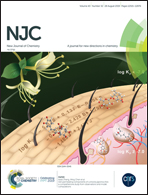Highly selective two-electron oxygen reduction to generate hydrogen peroxide using graphite felt modified with N-doped graphene in an electro-Fenton system†
Abstract
The selective two-electron oxygen reduction reaction (ORR) on the cathode in electrocatalytic advanced oxidation is a promising environmental recovery method. Highly efficient 2e− pathway ORR electrocatalytic materials for in situ electrochemical synthesis of H2O2 are extremely important, but developing low-cost, green-cleaning electrocatalysts remains a huge challenge. In this study, to solve this problem, we synthesized a nitrogen-doped graphene (N-graphene) metal-free electrocatalyst and an N-graphene–graphite felt (GF) cathode. N-Graphene and N-graphene–GF were characterized by scanning electron microscopy, Raman spectroscopy, X-ray electron spectroscopy and nitrogen desorption–adsorption. The electron-spin resonance technique was used to identify the presence of hydroxyl radicals (˙OH). N-Graphene–GF was more favorable for in situ H2O2 activation to generate ˙OH. Moreover, we also applied N-graphene–GF to an electro-Fenton (EF) system and investigated its electrocatalytic performance for oxygen reduction and pollutant degradation. N-Graphene–GF showed good performance in the selective two-electron ORR to produce H2O2 and excellent performance for the degradation of pollutants.



 Please wait while we load your content...
Please wait while we load your content...